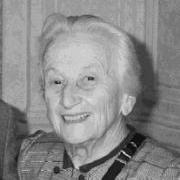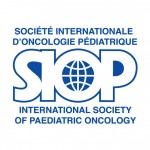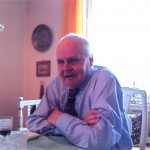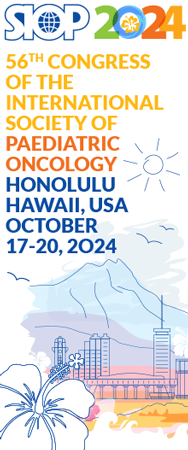A remarkable woman, pediatric pioneer, founder of SIOP†
BIOSKETCH
 Odile Schweisguth was born in 1913 in the Vosges. She was the last of five children. Her siblings between them had 29 children, but Odile Schweisguth never married. They were a very close family and would meet at least once a year with over 100 attending. The extended family included many prominent political and military figures.
Odile Schweisguth was born in 1913 in the Vosges. She was the last of five children. Her siblings between them had 29 children, but Odile Schweisguth never married. They were a very close family and would meet at least once a year with over 100 attending. The extended family included many prominent political and military figures.
Her father had been part of the occupying forces in Germany between 1919 and 1924. Thus, much of her early schooling was in Germany at the Lycée Français. She had started medical school in Nancy but, when her father retired in 1942, she transferred to Paris and qualified in Medicine in 1946. Dr. Schweisguth had decided on pediatrics from the outset and started her career at the Hôpital des Enfants Malades.
René Huguenin in 1948 was the Director of the Insitut Gustave- Roussy (IGR), the major cancer center located in Villejuif, Paris.He was looking for a pediatrician who would look after the children with cancer at the IGR. It was a difficult post to fill. No one was interested; the childhood malignant diseases were largely hopeless, and the ill children daunting. He turned to the prominent French pediatrician, Professor Robert Debré, who proposed Dr. Schweisguth for this unwelcome assignment. It was in this way that the first pediatric oncology service in France—indeed, in Europe—opened in April 1952.
She gained experience, and already in 1959 mounted the first postgraduate course on the leukemias and solid tumors of childhood. In the same year, she spent several weeks in the United States, which included 2 months at the “Jimmy Fund” Clinic, the childhood cancer center run by Professor Sidney Farber. There she absorbed the pervading optimism that childhood cancer was curable.
More than that, she observed the encompassing compassion for the children and their families. This aspect of pediatric oncology care was termed as “Total Care” by Dr. Farber. After years of additional experience, she, in 1970, published in the Archives de Pédiatrie a clarion call article titled, “Must they be left to die?” In this article, she encouraged the medical world to look on the progress being made in the control of the childhood malignant diseases and mobilize for the battle. Dr. Schweisguth also called attention to the need for family support, as the drama unfolded in each household. She was also aware of the psychologic dimensions of the specialty. She recognized the stress on the staff who looked after these very ill children, many of whom would die. She therefore initiated a psychologic/psychiatric service to provide support and help guard against undue stress and “burn out.” This was the first service of its kind. She encouraged lengthy visits to Villejuif by interested physicians from all corners of the country. In thisway, she trained virtually all pediatric oncology pioneers in France. She looked on herself as an oncology generalist as she for years had been a pediatric generalist. Dr. Zucker says, “I have never met a person like her, who could discuss on equal terms all aspects of diagnosis and therapy with the specialists in those disciplines.” This became manifest when as a sole author she wrote a book published in French and English entitled, “Solid Tumors of Childhood.” She was very cognizant of the delayed iatrogenic complications of therapy, and kept voluminous files on her patients who survived. Those records contained more than the medical highlights of the post treatment years. They also listed personal milestones: graduations, marriages, children born, and the like. She maintained an active correspondence with many patients who became “family friends.” She retired in 1978 at the age of 65 to her beloved country home in Cotâpre in Burgundy. Cotâpre is a small village, about 250 km from Paris. She nonetheless continued to follow up more than 500 of her surviving patients who were her second family and many were in touch with her for the rest of her life. These 500 children had between them 351 of their own children with only one case of cancer. One of her devoted long-term survivors had moved to the area to look after her in Cotâpre during her declining years. She died there in 2002.
THE BIRTH OF SIOP
 Odile had been the chief of pediatrics at Villejuif since 1951, and around Easter 1952, she managed to persuade the authorities to designate a separate ward for children. Prior to this, children had been treated in the adult wards. Her many attempts to get proper facilities came to a head when there was an outbreak of chickenpox in the ward. The adult nurses had been scraping the crusts off the chickenpox lesions and applying lotions. This resulted in the dissemination of this usually mild disease among the immune-compromised adult patients. Odile told them that she would take the children back to the children’s hospital if they did not give her a separate ward. She was a determined character only wanting what was best for the children. The facilities provided were cramped and spartan at best. Despite these drawbacks, it was a very happy place and Dr. Schweisguth, the nurses, and trainees worked together “like a family.” Eventually, Jean Lemerle joined her in 1966. At about this time, she began to receive visiting doctors from elsewhere in France as well as across Europe (e.g., Tom Voȗte from Amsterdam in 1968, among others). They would stay for a week or two or for several months. The Villejuif unit mainly looked after children with solid tumors, while Professor Jean Bernard looked after children with leukemia at the Hôpital St Louis in Paris. They had a good working relationship. Odile was the undoubted leader and pioneer of pediatric oncology in Europe, and in her travels, and visitors to her own unit, she built up a network of like-minded people who began to meet. These gatherings became more formal, and eventuated in the founding of SIOP, as explained in the Introduction.
Odile had been the chief of pediatrics at Villejuif since 1951, and around Easter 1952, she managed to persuade the authorities to designate a separate ward for children. Prior to this, children had been treated in the adult wards. Her many attempts to get proper facilities came to a head when there was an outbreak of chickenpox in the ward. The adult nurses had been scraping the crusts off the chickenpox lesions and applying lotions. This resulted in the dissemination of this usually mild disease among the immune-compromised adult patients. Odile told them that she would take the children back to the children’s hospital if they did not give her a separate ward. She was a determined character only wanting what was best for the children. The facilities provided were cramped and spartan at best. Despite these drawbacks, it was a very happy place and Dr. Schweisguth, the nurses, and trainees worked together “like a family.” Eventually, Jean Lemerle joined her in 1966. At about this time, she began to receive visiting doctors from elsewhere in France as well as across Europe (e.g., Tom Voȗte from Amsterdam in 1968, among others). They would stay for a week or two or for several months. The Villejuif unit mainly looked after children with solid tumors, while Professor Jean Bernard looked after children with leukemia at the Hôpital St Louis in Paris. They had a good working relationship. Odile was the undoubted leader and pioneer of pediatric oncology in Europe, and in her travels, and visitors to her own unit, she built up a network of like-minded people who began to meet. These gatherings became more formal, and eventuated in the founding of SIOP, as explained in the Introduction.
ANECTODES AND VIGNETTES
She refused France’s highest civil honor, the Legion d’Honneur. The minister was very upset but she asked, “Why do I need it?” Walking down the street in Mainz, she remarked to a friend that she had attended school there when a girl. “How was that?” She was asked. “My father was commanding general of the French occupying forces after WWI,” she replied. Sarah Donaldson recalls: Driving with Odile across Paris traffic was an experience! On my first trip with her, we found ourselves in the middle of a traffic jam, which she bypassed by driving her small car on the pedestrian walkway. When I questioned her action, she stated the obvious, that it was the only way to get around the obstacle.
Sir Alan Craft remembers that he was the SIOP President at the time
of her death and attended the funeral as a representative of the pediatric
oncology community. The family asked that he should speak a few
words at the ceremony. He had 2 hr for composing something suitable
in his remembered schoolboy French. There was a huge attendance
with many families. He told them what an important person “Tante
Odile” had been. They neither had any idea that their aunt was famous,
nor about her great contributions to the study and treatment of childhood
cancer.
Odile Oberlin remembers that Dr. Schweisguth—a dynamo for work—always had her knitting close at hand, perhaps so as to leave no minute idle. She knitted during both formal and informal meetings, even during SIOP scientific sessions. Giulio J. D’Angio remembers the first time he gave a speech at SIOP. Dr. Schweisguth stopped him immediately, saying “Dan, if you want to be understood, you must speak slowly and distinctly. Not everyone in the audience is a native English speaker!” It was her refrain at almost every meeting, and a lesson Dr. D’Angio never forgot.
Giulio J. D’Angio was present when Dr. Schweisguth visited the Boston Children’s Hospital. She asked whether methotrexate had been used against one of the solid tumors, and was told, “Yes, and it doesn’t help.” Her reply was pure Odile: “Please, may I see the charts?”
Berta Jereb remembers: I defended my Ph.D. thesis at the Karolinska
Institutet in Stockholm in 1973. It was a serious and very formal procedure. Odile Schweisguth was chosen as one of the opponents. My chief, Jerzy Einhorm, stressing the formality of the event, demanded that I should wear a gown. I insisted: “No Jerzy, I reallycannot. I am sure that Odile will come in her little blue dress. So, how would that look? But Berta, you must tell her she must wear a gown, too.” “No, Jerzy! How can I tell a lady from Paris how to dress? Who would dare?” Odile indeed came in her little blue dress and the examination proceeded uneventfully with neither of the two ladies in gowns.
 Lars Ǻhström vividly and gratefully recalls Toni Pieroni’s boundarybreaking lecture on ”Children with an amputated limb and their psyche” at the 1975 meeting. At that time, it was considered a taboo to mention psychologic consequences of cancer and its treatment. T. Pieroni was a social worker—the first such anywhere—at the ‘’Jimmy Fund Clinic’’ in Boston. Her staff appointment reflected Sidney Farber’s “Total Care” philosophy. A gavel of Swedish glass, especially made for SIOP, was given by the Swedish group at the 1975 Stockholm meeting, L. Ǻhström remembers. It was to be used by the SIOP President at future meetings. Where is it now?
Lars Ǻhström vividly and gratefully recalls Toni Pieroni’s boundarybreaking lecture on ”Children with an amputated limb and their psyche” at the 1975 meeting. At that time, it was considered a taboo to mention psychologic consequences of cancer and its treatment. T. Pieroni was a social worker—the first such anywhere—at the ‘’Jimmy Fund Clinic’’ in Boston. Her staff appointment reflected Sidney Farber’s “Total Care” philosophy. A gavel of Swedish glass, especially made for SIOP, was given by the Swedish group at the 1975 Stockholm meeting, L. Ǻhström remembers. It was to be used by the SIOP President at future meetings. Where is it now?
Jean Michel Zucker remembers that after finishing the careful examination of a toddler, Dr. Schweisguth used to sing a nursery rhyme or narrate a fairy tale to calm him down. Odile’s sense of humor mischievously showed itself by exposing at Cotâpre in her privy the numerous certificates she had gathered.
Thank you to Sir Alan Craft, Jean Michel Zucker,Sarah Donaldson, Giulio J. D’Angio.
The interested reader is directed to click here, where Dr. Donaldson’s warm and intimate memories of life with “Tante Odile” are recorded.




